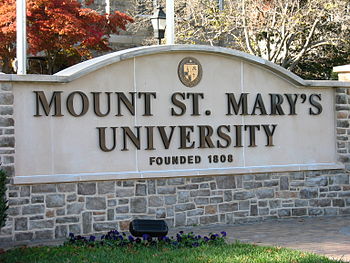 |
| The entrance sign to Mount St. Mary's University in Maryland, United States. (Photo credit: Wikipedia) |
This article originally appeared in Inside Higher Ed.
Is a valid strategy to improve a college’s retention rate to encourage students at risk of dropping out to do so in the first few weeks, so they won’t be counted in the total numbers reported to the U.S. Education Department and others?
That is a question raised by emails leaked to the student newspaper at Mount St. Mary’s University in Maryland. The emails suggest that the president had such a plan in motion—despite opposition from some faculty members and other administrators. The board chairman at Mount St. Mary’s released an open letter in which he did not dispute the emails but said they were taken out of context. The board chairman’s letter did not detail what was allegedly out of context. Primarily, his statement blasted student journalists for publishing the contents of confidential emails.
The president, Simon Newman, acknowledged to the Washington Post that he was pushing a plan to intervene early on with students who may be having difficulties. But he said that this was to help them, although he said that the help in some cases might be for them to see that they might be better off a less expensive public institution. The student newspaper also reported (and the Washington Post quoted a professor confirming) that Newman told some faculty members they needed to change the way they think of struggling students.
He reportedly said, “This is hard for you because you think of the students as cuddly bunnies, but you can’t. You just have to drown the bunnies … put a Glock to their heads.”
The president told the Post that he didn’t remember the language he used in that discussion. But he acknowledged that he sometimes uses harsh language, sometimes to his regret.
“I’ve probably done more swearing here than anyone else,” Newman told the Post. “It wasn’t intended to be anything other than, ‘Some of these conversations you may need to have with people are hard.’ ”
The emails quoted in the student newspaper, the Mountain Echo, suggest more than just trying to reach at-risk students. The emails describe using a survey given to new students to help identify those who may be likely to drop out. And then an email from President Newman says: “My short term goal is to have 20-25 people leave by the 25th [of September]. This one thing will boost our retention 4-5%. A larger committee or group needs to work on the details but I think you get the objective.”
According to Education Department data, the six-year graduation rate for full-time first-time students at Mount St. Mary’s is 66 percent, and 78 percent of freshmen return for a second year. While both rates are above national averages for four-year colleges, many private, residential colleges that serve traditional-age undergraduates boast of significantly higher rates.
A letter to the Mountain Echo from John E. Coyne III, chairman of the university’s board, does not dispute the various emails quoted in the article but says the article is based on “selected quotes” that give the article a “slant” and create a “grossly inaccurate impression on the subject of the Mount’s efforts to improve student retention.”
The letter goes on to criticize the newspaper’s editor, saying that the emails in question are confidential. “You propose to use those private, confidential emails to advance your journalistic interests and to do so without any concern for either the individual privacy interests of the faculty involved or the damage you will render to this university and to its brand,” the letter says.
Top Comment
Couldn't we just put them in the trunk and drive them a few miles into the country, to let them loose? More...
177 CommentsJoin In
Coyne adds that using confidential emails is “quite frankly irresponsible” and violates the college’s code of conduct.
Newman became president of Mount St. Mary’s last year. His prior career was not in higher education but in private equity and business. His biography says that he founded or co-founded four businesses and worked at various times for Bain & Co., JP Capital Partners, and Cornerstone Management Group.
No comments:
Post a Comment